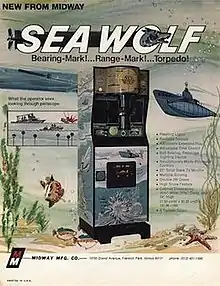Sea Wolf (video game)
Sea Wolf is a shoot 'em up video game by Midway, originally released in arcades in 1976.[1] It is a video game update of an earlier coin-operated electro-mechanical Midway game, Sea Devil,[2] itself based on Sega's 1966 coin-op electro-mechanical arcade submarine simulator Periscope.[3] Sea Wolf was designed by Dave Nutting and eventually sold 10,000 arcade cabinets.
| Sea Wolf | |
|---|---|
 Arcade flyer | |
| Developer(s) | Dave Nutting Associates |
| Publisher(s) | Midway Games |
| Platform(s) | Arcade, Commodore 64, VIC-20 |
| Release | |
| Genre(s) | Shoot 'em up |
In 1982, Commodore International produced cartridge ports of Sea Wolf for the VIC-20 and then-new Commodore 64 computers.[4]
Midway released a color arcade sequel, Sea Wolf II, in 1978 that sold another 4,000 units.[5]
Gameplay
The player looks through a large periscope to aim at ships moving across the virtual sea line at the top of the screen, using a thumb button on the right handle of the scope to fire torpedoes. The periscope swivels to the right and left, providing horizontal motion of a targeting cross-hair. The cabinet features a mixture of video game and older electro-mechanical technology for player feedback. Using back-lit transparencies reflected inside the scope, the number of torpedoes remaining are displayed, as well as a red "RELOAD" light which lights up momentarily when the player has launched five torpedoes. Additionally, when a ship is hit, a corresponding "explosion" light is reflected onto the screen image at the ship's approximate position. A blue overlay is affixed to the screen to provide a "water color" to the sea. Sounds include a sonar ping, the "whoosh" of launched torpedoes, torpedo explosions, and the klaxon sound of the PT boat racing across the screen.
Sea Wolf is time-limited, with the player having an opportunity to win bonus time by reaching an operator-set score. The player's score is shown on the bottom half of the screen as well as the high score, one of the first known instances of a high score in a video game.[6] Targets include destroyers, a fast-moving PT boat, and mines floating across the screen that serve as obstructions.
Legacy
Sea Wolf was followed by Sea Wolf II in 1978. In 1983 Epyx ported Sea Wolf II and another Midway game, Gun Fight, to the Atari 8-bit family and released them in an "Arcade Classics" compilation.[7]
In 2008, Coastal Amusements released a retro video redemption game based on the original Sea Wolf.[8]
High score
The current world record holder for Sea Wolf is Alan Radue with a score of 11,300 points. The record was set on October 2, 2011 at the Tranquility Base Arcade and verified by Twin Galaxies International on October 9, 2011.
References
- "Sea Wolf Killer List of Video Games Entry". Retrieved 2007-05-25.
- Marvin's Marvelous Mechanical Museum. "1976 Midway Sea Wolf". Archived from the original on May 3, 2007. Retrieved 2007-05-25.
- Steve L. Kent (2001), The ultimate history of video games: from Pong to Pokémon and beyond: the story behind the craze that touched our lives and changed the world, p. 102, Prima, ISBN 0-7615-3643-4
- "Sea Wolf for Commodore 64 (1982) - MobyGames". Retrieved 2012-06-07.
- Steven L. Kent (2000), The first quarter: a 25-year history of video games, BWD Press, p. 83, ISBN 0-9704755-0-0, retrieved 2011-04-09,
Sea Wolf, which was another creation of Dave Nutting, did solid business, selling more than 10,000 machines. (A later color version sold an additional 4000 units.)
- Medler, Ben (2009). "Generations of Game Analytics, Achievements and High Scores". Eludamos. Journal for Computer Game Culture. 3 (2): 177–194.
- "Arcade Classics: Sea Wolf II / Gun Fight". Atari Mania. Retrieved 2011-02-01.
- Shaggy. "Shaggy's Review – Sea Wolf by Coastal Amusements". Arcade Heroes. Retrieved 2011-06-28.